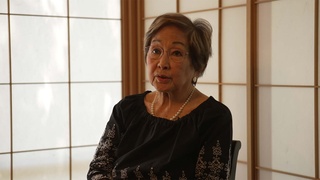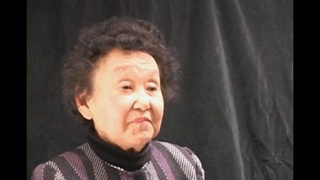Interviews
Clothes of plantation workers
For me, I think living in the hub of plantation life, right near the sugar mill, and every morning the train came to pick up the workers. I used to watch. Every morning, I got up with my father, at I think it was about 4am. And I would wait on the steps for him to use the outhouse because the outhouse was so far from the main house. And so I would wait for him and often watch the workers parading down the back dirt road with the bento can, you know, dangling. Like your grandfather, I think he was a plumber so he wore blue overalls. And so, people who worked in the plumbing shop and mill—maybe he was working at the mill. And I could watch him, every morning, he passed on the back road. He was such a kind, kind person and a good friend of my father. And so, all the workers, the carpenters wore white overalls.
And the women with… I don’t know how they do it, because they have to get up at 3am to make bento for their husband—you know, the double-decker bento—and cook breakfast for the husband, make miso soup and cook rice. So they had to get up really early and to put on all the layers of clothing. I don’t know how they got dressed so quickly. The clothing alone, with the jacket, cummerbund, skirt and the kyahan, the leggings, and the tesashi—all that would take time. And in spite of it, they were all ready to catch the train by 5:30. They have to be out in the dark.
Date: February 19, 2004
Location: Hawai'i, US
Interviewer: Lisa Itagaki, Krissy Kim
Contributed by: Watase Media Arts Center, Japanese American National Museum.
Explore More Videos

Backstory of Parents
(b. 1939) a businesswoman whose family volunterily moved to Salt Lake City in Utah during the war.


Great grandfather working in Hawaii
(b. 1952) Former banking executive, born in Hawaii

Grandfather Fujioka in Wailua
(b. 1952) Former banking executive, born in Hawaii

Coming home to his mother after the war
(1919 - 2015) Nisei who served in World War II with the 442nd Regimental Combat Team

Marriage and Family
(1914–2015) Nisei YMCA and Japanese American community leader

His family Traveled to Japan in 1940
(b. 1938) Japanese American. Hiroshima atomic bomb survivor

Early Childhood
(1914–2015) Nisei YMCA and Japanese American community leader

Adoption Story
(b. 1939) a businesswoman whose family volunterily moved to Salt Lake City in Utah during the war.

Spending time with children
(b.1926) Democratic politician and three-term Governor of Hawai'i


Food growing up
(b.1948) Nikkei from Southern California living in Japan.

Relationship with my father
(b. 1920) Incarcerated during World War II. Active member of the Japanese Canadian community


Arranged marriage
(b.1912) Japanese Canadian Issei. Immigrated with husband to Canada in 1931
